SQL Server 12 is out – how do you like the new features?
Most of Izenda’s customers use our ad hoc reporting platform to connect to a Microsoft SQL Server database. So, we are thrilled about some of the new capabilities available in SQL Server 12. Here are seven features we are super excited about:
1. Columnstore indexes
You may have heard about columnar databases such as vertical that run some queries 100x faster. These new indexes bring this feature to SQL Server. For a query like this, the database can process much more data because it does not have to read the the entire table to do the calculation. It optimizes on the specific column. This makes multi-terabyte database perform a lot faster when only certain columns are used for reporting on specific columns. A query like this could run orders of magnitude faster.
SELECT SUM(Freight) FROM Orders
2. SQL Azure Enhancements
You can now make individual databases on Azure up to 150GB. Additionally you can do an azure sync to an on-premise database at this scale. This accelerates cloud adoption to larger organizations who need more sophisticated reporting capabilities.
3. Hadoop Support
That’s right. The popular open source big data storage engine now integrates with SQL Server. Having Hadoop integrated into a SQL server deployment will greatly reduce support and maintenance costs and, of course, brings Hadoop into Microsoft shops. We are excited about this feature because Izenda Reports now has the ability to report on a variety of data sources through an integrated experience using Izenda Fusion.
4. AlwaysOn
You can now create multiple fail over mirrors with a lot less effort. As an added benefit, the fail over servers can be used in read-only mode for reporting.
5. Windows Server Core Support
For virtualization fans that want minimal overhead, you can now run SQL Server without the windows GUI and administer remotely. It has a lower footprint so queries should run faster, especially in a virtualized environment.
6. Enhanced Auditing
For customers with compliance requirements, you can not do better tracking of what SQL Server is doing in a more granular way.
7. Linux Client Support
If you haven’t heard, Microsoft is now one of the top contributors to the Linux Kernel. You can now connect to SQL Server databases from Linux applications. As strange as this feels, it’s definitely a good thing.

 Security experts far and wide cry loudly any time there is a suggestion about using cloud services for anything but the most routine of tasks. Hacking is a concern about which many are rightfully concerned.
Security experts far and wide cry loudly any time there is a suggestion about using cloud services for anything but the most routine of tasks. Hacking is a concern about which many are rightfully concerned. Many were predicted to die on January 1, 2000 – but mainframe legacy applications are still around. In some ways, they are the zombies of the IT world. Now they are running on the cloud as well. What are they and why are they still alive?
Many were predicted to die on January 1, 2000 – but mainframe legacy applications are still around. In some ways, they are the zombies of the IT world. Now they are running on the cloud as well. What are they and why are they still alive? “Spline” refers to both the curve and the mathematical algorithm for determining it. The word itself comes from the same root as “splinter”. Originally, splines were thin strips of wood used by boat builders to create curves. Builders used thin splints pulled into place by weights called ducks or knots. The wooden spline was flexible enough to easily curve when the ducks were moved or their weight changed. This allowed for extensive manipulation of the curve and resulted in the smoothest possible curve between two points.
“Spline” refers to both the curve and the mathematical algorithm for determining it. The word itself comes from the same root as “splinter”. Originally, splines were thin strips of wood used by boat builders to create curves. Builders used thin splints pulled into place by weights called ducks or knots. The wooden spline was flexible enough to easily curve when the ducks were moved or their weight changed. This allowed for extensive manipulation of the curve and resulted in the smoothest possible curve between two points. ATLANTA, GA (August 7 2014) – Embedded BI, visual, analytics and self-service reporting software provider Izenda (
ATLANTA, GA (August 7 2014) – Embedded BI, visual, analytics and self-service reporting software provider Izenda (